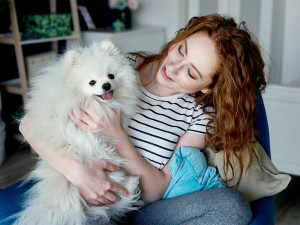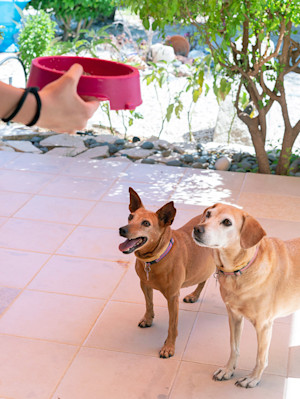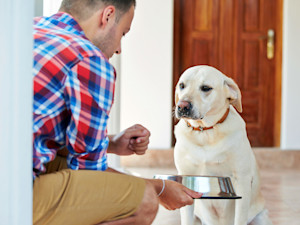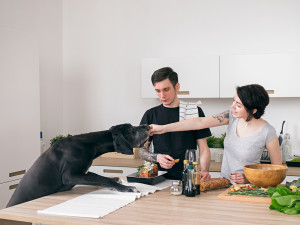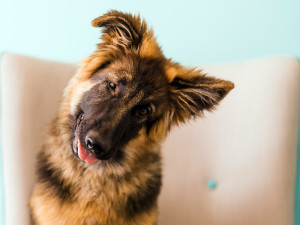What to Feed a Dog With Vestibular Disease
Healthy meals and supplements can help set them on a path to recovery.
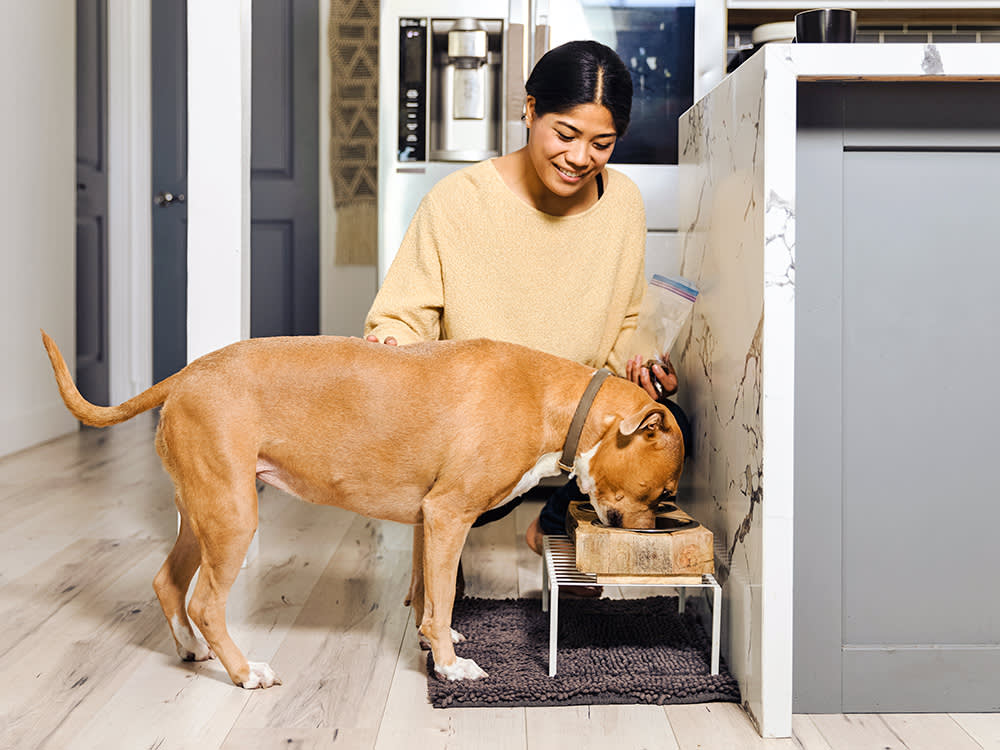
Share Article
In This Article:
What Is Vestibular Disease? Dietary Considerations for Dogs with Vestibular Disease Recommended Foods for Dogs with Vestibular Disease Supplements Homemade vs. Commercial Diets Feeding Tips When to Consult a Veterinarian
If your pup has recently been diagnosed with vestibular disease, it can feel overwhelming and scary. Between seeing your dog so out of sorts and your vet bills and providing a more intensive level of care for your dog at home — it can all feel like a whirlwind.
Amid all your concerns, you may not have given much thought to what to feed your pup in their current state. That’s okay: Take a breath, and snuggle your pup. In some cases the disease will resolve itself, in others, you may need medical intervention. Your vet will help you determine your dog’s treatment.
Either way, while nutrition plays an important role in healing, there are no specific foods that are going to cure vestibular disease (or cause it, for that matter). In most cases, feeding your dog their regular diet, or any safe, healthy foodsopens in new tab they want to eat will be the best approach. Below is some helpful advice to keep in mind.
Main takeaways
There are no specific foods that can treat this condition, but good nutrition is important for healing.
Getting a sick dog to eat and stay hydrated can be challenging, so get creative if your pup isn’t psyched about their food right now.
A complete, balanced diet is always best for your dog’s long-term health, but in the short term, you may need to compromise to keep your pup eating.
How much do you spend on your pet per year?

What is vestibular disease?
Vestibular disease is a term for many different conditions that affect the vestibular system, or the mechanisms that influence balance. It’s similar to vertigo in people: When a dog has vestibular disease, they feel very dizzy and might lose their balance and fall over.
Depending on the severity of the disease, some dogs with vestibular disease may not be able to walk at all, they may drool, feel nauseous, and/or vomit. They may also have nystagmus, or rapid movements of their eyes. While the signs are always similar, the underlying causes of vestibular disease can vary.
The most common cause is a condition in senior dogs known as “old dog” vestibular disease, or idiopathic vestibular disease — meaning there is no clear underlying cause, but it seems to occur with age. Other common causes of vestibular disease include inner ear infections, traumatic injuries, infections, hypothyroidism, or tumors. Depending on the underlying cause, dogs may also have additional symptoms.
Dietary considerations for dogs with vestibular disease
The biggest dietary consideration for dogs with vestibular disease is that they may not have much of an appetite. They often feel dizzy, nauseous, and may even be vomiting, so the smell of food may be a big turn-off to them. But eating and drinking are critical for them to stay hydrated and strong (and ultimately heal), so it’s important to be proactive in getting your pup to eat. This may require some creative coercion to meet your pup’s needs. Here’s what to keep in mind during this time.
Hydration needs
If a dog is not eating and drinking consistently, they are at risk of dehydration. This can be further exacerbated if they are drooling or vomiting, because both of those symptoms cause them to lose additional fluids.
However, your dog doesn’t need to drink loads of water to stay hydrated. They can also get water from their food, especially if they are eating canned food, broth, or other foods with high water content. If your dog does not eat or drink at all for 24 hours, it is important to take them to a vet to avoid more severe dehydration.
Common dietary adjustments
If your dog’s appetite has decreased due to nausea, you may need to adjust what you are feeding them. The goal is to keep them eating consistently, so even if that means offering home-cooked options or special treats, that is fine in the short term — as long as the food is safe and healthy for your dog. Stick to simple, bland foods that may be easier for your pup to tolerate, and be prepared to try a variety of options to see what works.
Importance of nutrition during recovery
Good nutrition is crucial to recovery. Sick dogs actually have a higher metabolic need for nutrients due to the stress response that accompanies an illness. Dogs without adequate nutrition can experience delayed wound healing, loss of muscle, and reduced immune function.
Recommended foods for dogs with vestibular disease
The best diet for any dog is a complete, balanced dog-food diet, crafted to include all of the nutrients that dogs need in the proper proportions to prevent deficiencies. If your dog’s appetite is as strong as ever, stick with their regular diet to ensure proper nutrition and to avoid establishing patterns where your dog expects a lil’ something extra at every meal. However, if your dog is not eating, you’ll want to tempt them with a variety of safe, healthy foods that will keep them hydrated, strong, and in peak healing performance. These include the following types of food.
Easily digestible proteins
Protein is a great source of energy, keeps dogs full, and provides crucial amino acids, which act as building blocks necessary for healing and repairing the body. You can try offering your dog plain white-meat chicken, scrambled eggs, fish, tofu, or even low-fat plain yogurt to see which proteins appeal to them. Always be sure the foods you offer are free of bones, skin, seasonings, and high-fat oils and butter.
Healthy carbohydrate sources
Carbohydrates are quick-acting energy, easily digestible, and may be more appealing to dogs that are feeling nauseous. Some good choices for dogs: small amounts of plain white rice, pasta, or skinless potato mixed with a protein source.
Essential fats
Fat is a great source of energy for dogs, providing important nutrients while keeping their skin and fur strong and healthy. Many dogs also find the smell and taste of fat very appealing, so it can be a good option for dogs who are not interested in their regular food. However, certain high-fat foods are not safe for them. These include fatty cuts of meat, fried foods, and high-fat dairy products — all of which can cause digestive issues and/or pancreatitis. Safe choices to try include fatty fish like salmon (with the skin and bones removed), plain unsalted peanut butter, and/or lean meats such as chicken.
Supplements
If your dog is eating balanced dog food, supplements are not necessary, because they are getting all the nutrients they need from this food. However, if your dog has a finicky appetite, and you are giving them a rotation of home-cooked favorites, consider supplements to avoid nutritional deficiencies.
In the short term, this is not a serious concern, because the hope is that within a few days, your dog will go back to their regular, balanced diet. Plus, if your dog is being selective about what they’ll eat now, you may not want to rock the boat by adding in a bunch of supplements that could affect the smell or taste of their food. Ask your vet to suggest the best supplements, which will depend on your dog’s specific diagnosis.
Homemade vs. store-bought diets
For the long-term health of your pup, a balanced dog food diet is the most reliable way to ensure their nutritional needs are met. In most cases, this is also the most affordable option.
Homemade diets, in contrast, come with some potential complications. It can be nearly impossible to make them balanced unless you work with a veterinary nutritionist to combine their home-cooked food with their kibble. It’s also more expensive to buy fresh ingredients every few days since these diets are not shelf-stable.
However, if your pup is sick and just doesn’t want to eat, you may need to go off-script and focus on getting food into your pup. If your dog is being especially finicky, or this goes on for more than a few days, be sure to speak with your vet. They may suggest a specialized prescription diet that’s high in calories. Or your dog may need additional support including IV fluids and/or additional medications to control their nausea, stay hydrated, and improve their appetite.
Feeding tips
In addition to trying a variety of foods, there are some other ways to entice your pup to eat.
Warm up their food: Dogs find warm food more appealing, and this can also enhance the smell of their food.
Offer small, frequent meals: If your dog isn’t gobbling down a full meal like they normally do, try to offer small amounts of food every few hours. This way, you can maintain their overall caloric intake, but make it more manageable for them.
Try canned food: Many dogs prefer the texture of canned food to dry food, so try offering different flavors of canned food in addition to their kibble.
Hand-feed your pup: If your dog is dizzy and nauseous, their symptoms may worsen if they try to stand, walk, or lean over their bowl. Try putting a little food in your palm and offering it to your pup to see if that makes it easier. But never force food into your dog’s mouth — this can lead to choking and/or food aversions.
When to consult a veterinarian
If at any point during your dog’s illness you are concerned, reach out to your veterinarian. If it’s your first time caring for a dog with vestibular disease, it can be very difficult to know what to expect, and is different for each dog, too. Your vet can help you determine what your dog needs throughout their illness. Some specific signs that require veterinary attention include:
Not eating or drinking at all for 24 hours
Worsening signs of their vestibular disease or any new signs that weren’t there before
Signs of severe illness, including difficulty breathing, seizures, collapse, and/or unresponsiveness
FAQs
Why won’t dogs with vestibular disease eat?
Because dogs with vestibular disease typically feel dizzy and nauseous, they can become averse to eating.
Will my dog be like this forever?
No, most cases of vestibular disease improve over time. Dogs with idiopathic vestibular disease and/or inner ear infections usually show improvement within days to weeks. If a dog has a more long-term diagnosis such as a brain injury or tumor, it can be more difficult to predict whether or not they will improve. So you should discuss the prognosis with your veterinarian.
How can I help my dog with vestibular syndrome?
Dogs with vestibular disease may be dizzy and fall over, so it is important to create a safe, padded space where they can rest without risk of injury. They may need to be carried or supported to walk, and they may need medications to help with their nausea. They may also need to be hand-fed and/or tempted with special food to encourage them to eat.
Why is my senior dog with vestibular disease not eating?
If your senior dog has been diagnosed with idiopathic vestibular disease, they are probably not eating because they feel dizzy or nauseated. It is very important to have your vet do a thorough check-up on them for any underlying health problems that may be compounding your dog’s illness and poor appetite. Senior dogs may have multiple health problems, so it is always important to get a full picture of their health.
Bottom line
Dogs with vestibular disease need extra care and support to get through their illness, and this includes nutritional support.
It is okay to tempt your dog to eat with a variety of foods, as long as they are safe and healthy for dogs.
Get creative to make your pup’s food more appealing, and try lots of different flavors and techniques to see what works.
Always consult your vet if you are concerned, especially if you can’t get your dog to eat for a whole day.
References
Brooks, Wendy. “Vestibular Disease in Dogs and Catsopens in new tab.” Veterinary Partner, 24 September 2019.
“Complete and Balanced Pet Foodopens in new tab.” US Food and Drug Administration, 28 February 2020.
Corbee, Ronald J. et al. “Nutritional Support of Dogs and Cats After Surgery or Illnessopens in new tab.” Open Journal of Veterinary Medicine, vol. 4, no. 4, 2014.
Linder, Deborah E. “What Nutrients are Essential for my Pet?opens in new tab” Cummings School of Veterinary Medicine Petfoodology, 9 May 2023.

Dr. Amy Fox, DVM
Amy Fox, DVM is a small animal veterinarian in New York City with over thirteen years of experience in a mixture of general practice, emergency medicine, and shelter medicine. A lifelong animal lover, Dr. Fox studied biology in college and then worked as a veterinary nurse before pursuing veterinary school at Cornell University. Her expertise includes surgery, dentistry, and management of chronic conditions, and she is interested in toxicology, pain management, nutrition, care of senior pets, and educational outreach. Dr. Fox also enjoys writing about veterinary medicine and teaching, and her work has previously appeared in Spruce Pets. In her free time, she loves to cook, garden, go for long runs, and hang out with her goofy mixed-breed dog May, who provides never ending comic relief!
Related articles
![Man trying to tempt dog to eat his kibble.]()
How Long Can Dogs Go Without Eating?
If you ask them, they would say they should be eating always. But here’s the truth.
![Side view of a cute hungry dog standing next to a red bowl with food in a studio with white background]()
How to Get a Dog to Eat
You can’t appease your picky new dog with chicken nuggets like you can with your toddler. Here are some things you can do.
![Close Up Of Female Owner Feeding Border Terrier Puppy With Dry Dog Food At Home.]()
The Ultimate Guide to Your New Dog’s Nutrition
From kibble to homemade food, these tips will help you learn the fundamentals of dog nutrition.
![pet parents making homemade dog food cheaper for black dog climbing on counter]()
Is Cooking Your Dog’s Food Worth it?
A nutritionist on dogs’ unique dietary needs, important ingredients, and other pro tips for home-cooked dog food.
![A German Shepherd Puppy sitting on a pink couch with head tilted]()
Call Alfred Hitchcock — Can Dogs Get Vertigo?
Learn the signs to look out for this condition.
